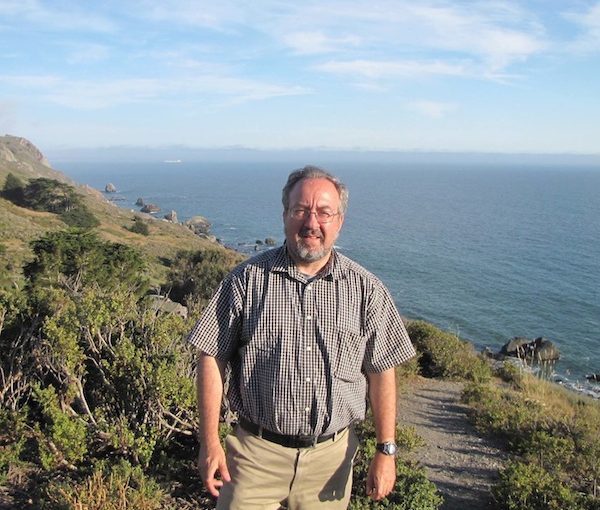University of Victoria’s Prof. Dan Russek spoke about Jewish writers in Argentina and Mexico, as well as Jorge Luis Borges’ Jewish-related writings. (photo from Dan Russek)
Dan Russek spoke on 20th-century Latin American writers, both Jewish and those who have been influenced by Jewish themes, at a Jan. 10 Zoom event organized by Congregation Emanu-El in Victoria.
Entitled The Golem Dances the Tango, the talk began with discussion of four Jewish authors – Alberto Gerchunoff and Ana Maria Shua of Argentina and Margo Glantz and Myriam Moscona of Mexico – before examining Argentine Jorge Luis Borges’ Jewish-related writings.
Gerchunoff (1883-1950) painted an idealized version of Jewish life in the Argentine countryside in his writings, with religious Jews as peasant farmers in a new land, explained Russek, an associate professor in the University of Victoria’s department of Hispanic and Italian studies.
In his best-known work, The Jewish Gauchos of the Pampas, a series of vignettes, “Gerchunoff was keen to find parallels between peasant life in Argentina and the Bible, and explore the interaction between Jews and the local residents,” Russek said. In one story, El Episodio de Myriam, a Jewish girl from a pious family elopes with a non-Jewish boy, causing uproar in the community.
Shua represents a more modern writer, less attached to traditions, said Russek. In her 1994 novel The Book of Memories, an anonymous narrator tells the story of the Rimetka family. “Gossip reigns supreme in this fictionalized account of a family. One feels as though we are witnessing a family dinner, perhaps a seder,” Russek explained. The narrator presents different and sometimes contradictory accounts, he said, creating a “series of foibles and misadventures with no end.”
Mexico’s Glantz incorporates much of her family story into her most-recognized book, The Genealogies, published in 1981. The daughter of immigrants from Ukraine, her father, Jacobo Glantz, was a promoter of Jewish intellectual life in Mexico, and once penned a poem about Christopher Columbus in Yiddish.
The Genealogies “is a form of literature as transcription and personal document,” Russek said. “It is a family story centred on her parents and her own coming of age. In Glantz, we see an adoption of Jewish culture but not of Jewish faith nor a strong sense of belonging.”
Moscona, a poet, journalist and translator, was the most contemporary writer of the four. Born in Mexico City to Ladino-speaking Bulgarian immigrants, her autobiographic novel Tela de sevoya explores her quest to find her cultural and linguistic heritage.
Russek then discussed Borges, a Judeophile who had several Jewish friends, from his time studying in Geneva, as well as literary mentors, such as Baruch Spinoza and Franz Kafka. Borges credited his English Protestant grandmother for providing a passion for Israel through a love of the Bible, and recognized Judaism as a pillar of Western Civilization.
In 1934, early in his literary life, Borges wrote an article called “I, A Jew,” which was a defence against an attack from a fascist magazine accusing him of hiding his Jewishness. In it, Borges says he would not mind at all being Jewish.
Borges lauded Israel in his poetry. In his 1969 collection In Praise of Darkness, he views Israel as a place that transcends Jewish history and the stereotypes associated with Jews. Two of the poems were written after the Six Day War and herald Israeli heroism on the battlefield.
In “Israel, 1969,” Borges writes, “You shall forget your parents’ tongue and learn the tongue of Paradise. / You shall be an Israeli. / You shall be a soldier. / You shall build the homeland with swamps, you shall erect it in deserts.”
Jewish characters and themes appear in “The Secret Miracle” and “The Death and the Compass.” And Borges had an abiding interest in kabbalah, which is documented in his essays and lectures. About his story El Aleph, Borges wrote: “In the kabbalah, that letter [aleph] signifies the En Soph, the pure and unlimited godhead; it has also been said that its shape is that of a man pointing to the sky and the earth, to indicate that the lower world is the map and mirror of the higher.”
Russek concluded with Borges’ poem “The Golem,” from the 1964 book El otro, el mismo. “Despite the logical structure of the poem, the theme deals with magic, myth and religion. The main philosophical/theological subject is the relationship between the creator and its creatures,” Russek said.
Russek is the author of Textual Exposures: Photography in 20th-Century Latin American Narrative Fiction and the upcoming Exercises in Urban Mysticism, a book of illustrated poetic prose. He coordinates Victoria’s annual Latin American and Spanish Film Week at Cinecinta.
Sam Margolis has written for the Globe and Mail, the National Post, UPI and MSNBC.

